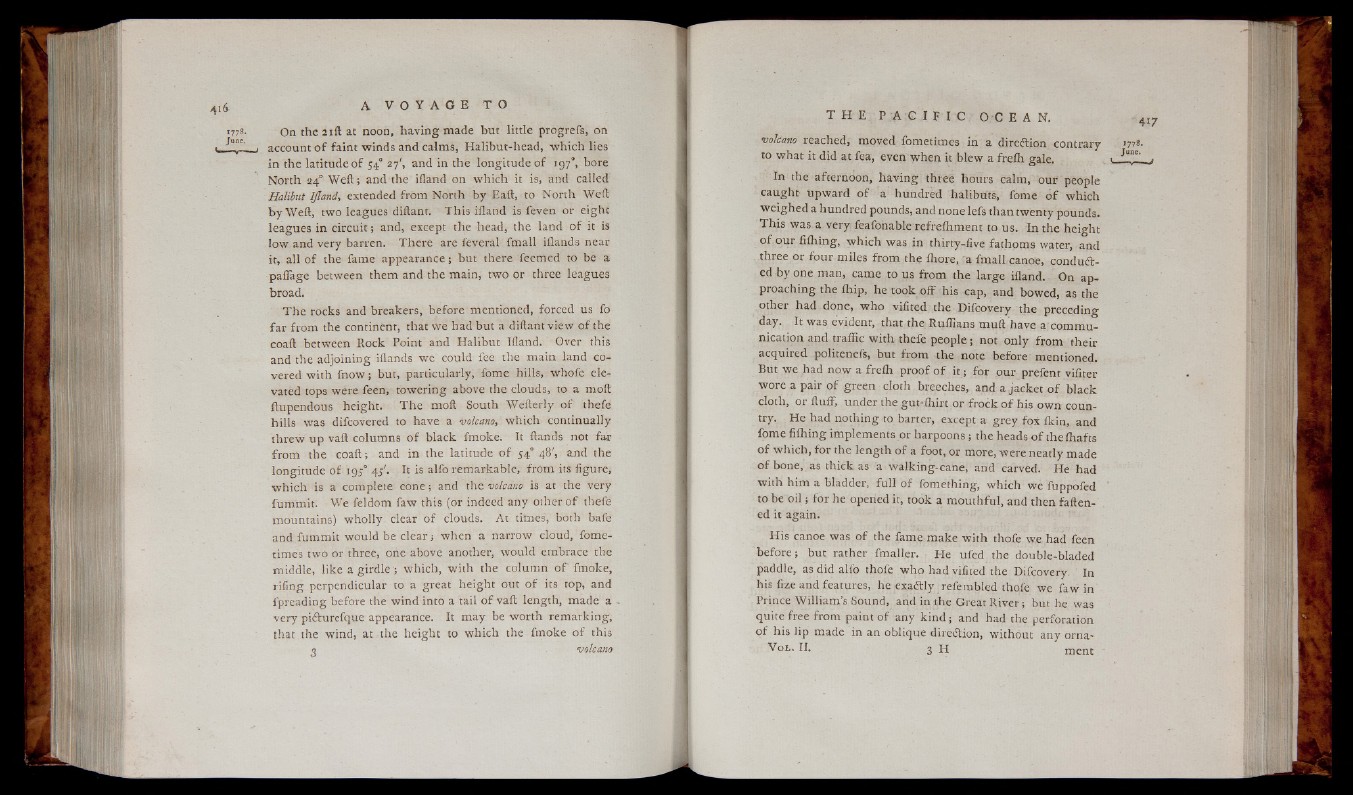
On the 2 1 ft at noon, ha vin g made but little progrefs, on
account o f faint winds and calms, Halibut-head, which lies
in the latitude o f 540 27', and in the longitude o f 1970, bore
North 24° W e ft ; and the iiland on which it is, and called
Halibut IJland, extended from North b y Eaft, to North Weft
b y W eft, two leagues diftant. This iiland is feven or eight
leagu es in c ir cu it ; and, except the head, the land o f it is
low and very barren. The re are feveral fmall iflands near
it, all o f the fame appearance; but there feemed to be a
paffage between them and the main, two or three leagues
broad.
T h e rocks and breakers, before mentioned, forced us fo
fa r from the continent, that we had but a diftant view o f the
coaft between Rock Point and Halibut Iiland. Over this
and the adjoining iflands we could fee the main land covered
with fn ow ; but, particularly, fome hills, whofe elevated
tops were feen, towering above the clouds, to a moft
itupendous height. T h e moft South Wefterly o f thefe
hills was difcovered to have a volcano, w hich continually
threw up vaft columns o f bla ck fmoke. It Hands not far
from the co a ft; and in the latitude o f 54° 48', and the
longitude o f 195° 4j '. It is alfo remarkable, from its figure,
w hich is a complete c o n e ; and the. volcano is at the very
fummit. We feldom faw this (or indeed any other o f thefe
mountains) w ho lly clear o f clouds. At times, both bafe
and fummit would be clear 5 when a narrow cloud, fome-
times two or three, one above another, would embrace the
middle, lik e a girdle'; which, w ith the column o f fmoke,
riling perpendicular to a great height out o f its top, and
fpreading before the wind into a tail o f vaft length, made a
very piiturefque appearance. It ma y be worth remarking,
that the wind, at the height to which the fmoke o f this
j 1 volcano
volcano reached, moved fometimes in a dircclion contrary ,7?8-
to what it did at fea, even when it blew a freih gale. ■ J“”e~ .■
In the afternoon, h a vin g three hours calm, our people
caught upward o f a hundred halibuts, fome o f which
w eighed a hundred pounds, and none lefs than twenty pounds.
T h is was a v e ry feafonable refreffiment to us. In the height
o f our fiihing, w hich was in thirty-five fathoms water, and
three or four miles from the Hr ore, a fmall canoe, c o n d u c ed
by one man, came to us from the large iiland. On approaching
the ihip, he took o ff his cap, and bowed, as the
other had done, who vifited the Difcovery the preceding
day. It was evident, that the. Ruffians m u flh a v e a communication
and traffic with thefe p eop le ; not only from their
acquired politenefs, but from the note before mentioned.
But we had now a freffi proof o f i t ; for our prefent vifiter
wore a pair o f green cloth breeches, and a jacket o f black
cloth, or fluff, under the gut-ihirt or fro ck o f his own country.
He had nothing to barter, except a grey fox ikin, and
fome fiihing implements or harpoons ; the heads o f theihafts
o f which, for the length o f a foot, or more, were n eatly m ade
o f bone, as thick as a walking-cane, and carved. He had
with him a bladder, fu ll o f fomething, which we fuppofed
to be o i l ; for he opened it, took a mouthful, and then fattened
it again.
His canoe was o f the fame make with thofe w e had feen
b e fo re ; but rather fmaller. He ufed the double-bladed
paddle, as did alfo thofe who had vifited the Difcovery. In
his fize and features, he e x aC ly refembled thofe we faw in
Prince William’s Sound, and in the Great R iv e r ; but he was
quite free from paint o f any k in d ; and had the perforation
o f his lip made in an oblique direction, without any orna-
V o l. II. 3 H ment